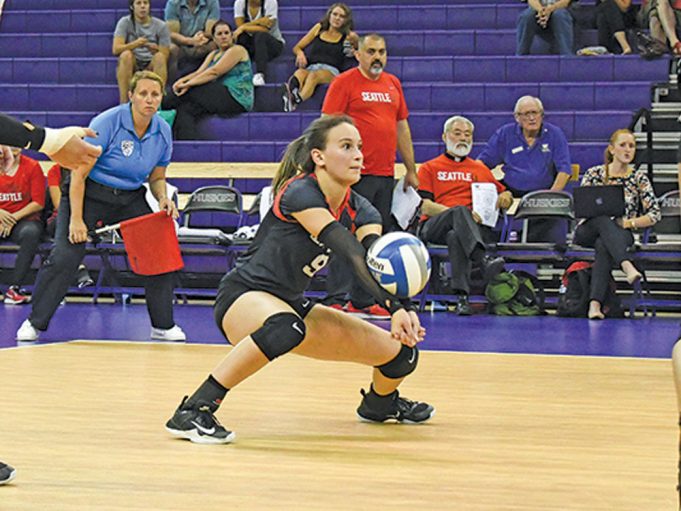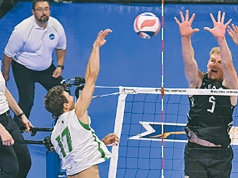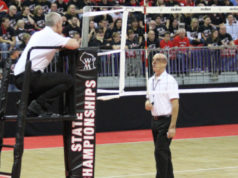Line judging, at any level, has its challenges. The game can move quickly and there are so many things to watch and think about as you prepare to make a call. Being able to read and react quickly are keys to getting the call right.
Here are some tips and techniques to consider to help take your game to the next level.
Pregame With Officials
As a line judge, be sure to take an active role in the prematch discussion with the officials. While it’s important to listen, it’s just as important to ask questions. Does the first referee have preferences about a secondary signal? Are there specific instructions about this particular match or venue?
The more prepared you are, the more confident you will be.
Pregame With Partner
Being on the same page as your partner can make the match go smoother and look more professional. With your partner, decide when and how long you’re going to warm up. Determine where your flag will be held as you walk to your timeout position and during timeouts or challenges. Determine whether you will be leaving the timeout position early, or if it will always be on the 15-second mark. Sometimes TV determines this. The more in sync you are, the more professional it will look.
Warming Up Your Eyes
This is your time to get used to the court, lines, lighting and surrounding areas, as well as player tendencies, arm swings and serves. It’s OK to stand in an upright position during warmups but don’t be afraid to get low. This gives you the chance to view the hitters and potential blockers in your ready position. Sometimes the lights or stands beyond the court look different when in a lower position. Be sure you practice seeing all perspectives.
Inside-Out Technique
The inside-out technique is an advanced technique and can initially seem counter-intuitive. However, it can improve your ability to judge close plays more accurately. On sideline and endline shots, position your head so you are looking at the line from the inside of the court out. You will have to lean a bit to accomplish this. By doing this, you will more easily see the small gap between the back of the ball and the line on balls that are just out. When you look from the outside of the court to inside the court, balls that are just out seem to be touching the line, which can lead to an incorrect call.
Watch the Hands
Touches on the block can be difficult to see, especially when you’re also trying to watch your lines. As the blockers go up, watch for the fingertips, and stay with them as long as possible. This will allow you to see even the minor touches. Remember, it’s important to leave the hands with enough time to get your eyes to your line. There are three other officials that can help with touches, but only you are watching your lines.
Beating the Ball to the Line
This technique means before the ball lands, your eyes, and possibly your head as well, are turned and looking at the sideline or endline. This allows you to better judge the ball. If you are following the ball, you may be too late to see where it lands, or your judgment of where it lands will be off.
Get Stopped
Whether it’s your feet, your flag or maybe just your eyes, you are constantly moving as a line judge. Yes, you should move to see pancakes and tips. Yes, you might have to move to see the blockers or your lines, but your head and body should be stopped and still as you see the ball land. This gives you the best vantage point and allows you to judge the ball accurately.
Moving With Purpose
It’s important to maintain your presence on the corner, but there may be times when moving is your best option. Be alert to a player or players coming toward you to chase a ball. Avoid going in the same direction as the ball. Try to move in such a way that you can stay square to the court and be able to judge if the retrieved ball will go over or outside the antenna. It’s best to back up if possible without turning your back to the court so you can still help with the play.
That Dreaded Corner
It’s never easy when the ball is hit directly into your corner, or worse, right at your feet. You may be tempted to jump out of the way to avoid getting hit, or think you have a better angle if you back up. If you can pick the right line from which to extend, get back far enough and get stopped to see the ball land.
The better option may be to hold your ground. You know where your feet are on the corner. You know you are stopped and can judge the ball more accurately while still. Getting a good angle on these shots is difficult, and you must make a quick decision about what to do.
Remember to Relax
While the ball is in play, your mind and body should be fully engaged and focused. It can be intense. Take a moment after each play, especially those long rallies, and relax. Take a deep breath, loosen your shoulders, adjust your feet and mentally prepare for the next serve. Taking a second to refocus will help you fully engage in the next point.
Line judging can be very challenging and rewarding at the same time. There is always something to think about or focus on as you watch each rally. Hopefully you can use one or more of these tips to help take your game to the next level.
What's Your Call? Leave a Comment:
Note: This article is archival in nature. Rules, interpretations, mechanics, philosophies and other information may or may not be correct for the current year.
This article is the copyright of ©Referee Enterprises, Inc., and may not be republished in whole or in part online, in print or in any capacity without expressed written permission from Referee. The article is made available for educational use by individuals.


















